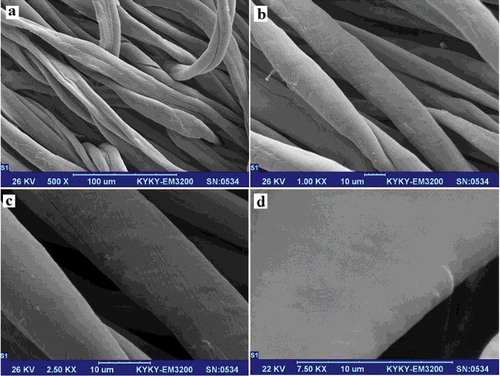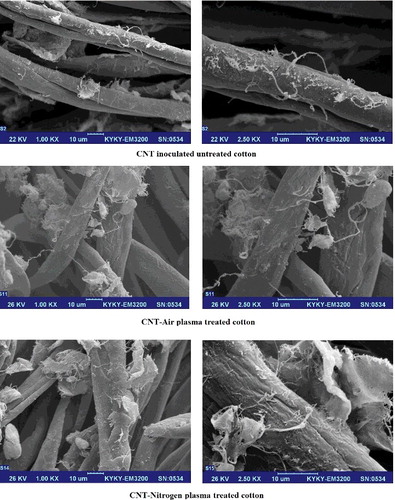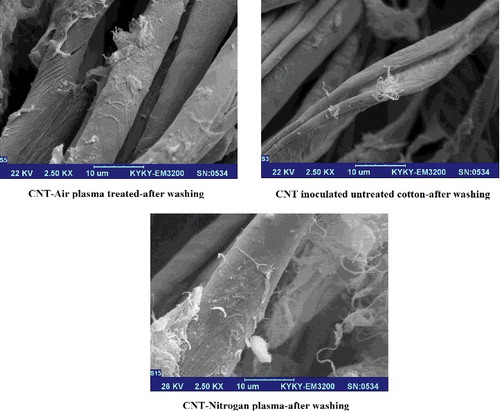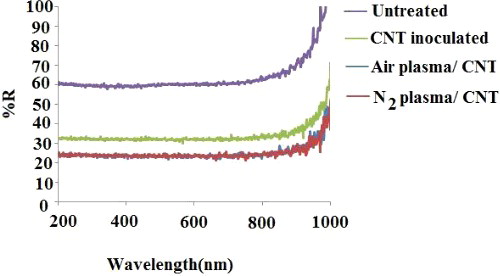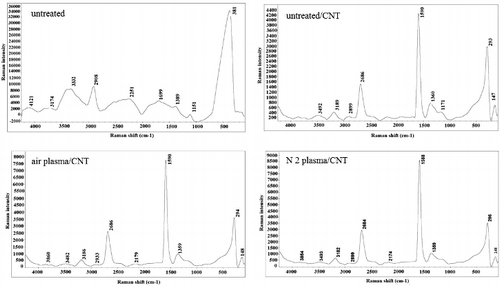Abstract
In this study, effect of plasma pretreatment on the absorption of carboxilated carbon nanotubes (CNTs) on the surface of cotton fabrics was investigated. Treated samples were characterised using a Raman spectrophotometer. Also, the morphological properties of samples were studied using a scanning electron microscope. Electrical resistance and interactions between CNTs and plasma-treated cotton functional groups at the surface were also evaluated. Antibacterial activity of cotton fabric when modified by low temperature plasma and stabilised with CNTs was also investigated. Results showed a uniform coating of CNTs on the plasma-treated cotton fabric and it was found that the plasma treatment is effective on improving CNTs absorption by cotton fabric. Generally, cotton fabric characterisation, such as antibacterial activity and electrical conductivity, after plasma treatment and loading CNT are improved.
1. Introduction
Demand for the development of electronic textiles (e-textiles) and antibacterial textiles are rapidly growing for industrial applications such as sensors, electromagnetic interference shielding, dust-free clothing, monitoring, military applications, data transfer in clothing and health care. Therefore, it is important to modify the properties of textile.[Citation1,Citation2]
Carbon nanotubes (CNTs) are new fascinating materials. Basically, they are fullerene-related structures composed of graphite cylinders, which are closed at either ends with caps consisting of pentagonal rings. Based on the number of walls, nanotubes can be classified into two major categories, single-walled nanotubes (SWNTs) and multi-walled nanotubes (MWNTs,). Due to their exceptional properties, they have been used in several diverse and application areas. Electrical conductivity of MWNTs with current densities is greater than 107amp/cm2.[Citation3,Citation4] On the other hand, fabrics made of conventional textile materials generally have high electrical resistivity (>1010 Ω).[Citation5]
Individually, CNTs have extreme mechanical, electrical and thermal properties. Transferring these properties to the macro-scale has been the subject of many research publications.[Citation6–8]
All the previous studies on the use of CNTs for textile functionalisation were focused on two methods of fiber spinning by compounding and dipping-drying. The previous studies have indicated that CNT-incorporated polymeric composites exhibit satisfactory physical, chemical and mechanical properties.[Citation9–12]
To enhance CNT's adsorption on cotton fabric and increase the uniformity of its distribution, it is necessary to develop active groups on the fabric surface and increase the surface energy of cotton fibers. To achieve this, one of today's definition methods is the low-temperature plasma (LTP) treatment of fabrics.
The technique of plasma treatment is an effective surface modification method to save processing costs and to avoid environmental pollution.[Citation13]
LTP has good modification effect on materials, and has been widely used in the area of material modification. By Zhang et al. [Citation14] in 2012, the surface of MWNTs was modified by atmospheric pressure air dielectric barrier discharge (DBD) plasma, after which gas sensors based on MWNTs were fabricated. They concluded that after modification by DBD, the sensitivity and response time of MWNTs gas sensors were greatly improved.
However, to our knowledge, there is no report introducing the applying of CNTs on plasma-pretreated fabric by exhaustion method. Different physical and chemical properties of the plasma-treated/CNT-stabilised fiber were investigated in the present study.
2. Experimental
Bleached plain-woven cotton fabrics (100%) prepared from Yazd Baf Co were washed for 10 minutes at 40 °C with water solution containing 1 g/l of a non-ionic detergent before LTP treatment to minimise the effects of contamination and dried at room temperature. Carboxylated single-wall nanotubes of 90% purity were provided by Neutrino Co, (1–2 nm diameters and 30 μm length, made in USA). Tryptic soy agar was supplied by Liofilchem (bacteriology products), Italy. The used surfactant was SDS (sodium dodesyl sulphate) provided by Merck Chemical Co., Germany.
DC magnetron-sputtering device was used for plasma treatment. Air and nitrogen gases were used as working gases. Also, an Al post cathode was used because of its lower sputtering rate. The chamber was pumped down to 2 × 10−3 torr using a rotary pump, and then Air or N2 was admitted into it up to a pressure of 5 × 10−2 torr. The current and voltage of the system were kept constant at 200 mA and 1000 V and the time of exposure according to the previous research works was fixed at 5 minutes.[Citation15,Citation16]
All samples were inoculated with 2% single-walled carboxylated CNTs and 2% SDS, in an ultrasonic machine (EuroSonic 4D, EURONDA, Made in Italy) for 45 minutes at 60 °C. And then, an ultrasonic washing was done on all specimens for 30 minutes at 60 °C.
The morphology of untreated and treated cotton fabrics were characterised by scanning electron microscopy (SEM, Philips, XL30, and Made in Netherland). The surface of each sample was first coated with a thin layer of gold by physical vapour deposition using a sputter coater (SCDOOS, BAL-TEC, Swiss made).
The Raman spectroscopy instrument was Almega Thermo Nicolet Dispersive Raman Spectrometer. A single cotton fiber was chosen from the prepared samples and placed on a glass plate. Multiple scans (32 scans), which take around 3 minutes with resolution at 4 cm−1 and the spectral range between 100 and 4200 cm−1, were performed. The source of laser used was second harmonic at 532 nm wavelength of an Nd: YLF laser.
The reflection factor (R) and colour intensities of CNT-inoculated fabrics were measured and compared using an ultraviolet visible near-infrared (UV-Vis-NIR) reflective spectrophotometer (Cary 500, Varian) over the range of 200–1000 nm.
Also, water droplet absorption time was determined as the average absorption time of four water droplets placed on different parts of each sample.
The electrical resistance measurements were also performed on all samples after conditioning the samples in a standard atmosphere. The resistance was measured 10 times on each side of the samples and the average values were taken. The standard AATC 76-1995 was used to measure the resistance of the samples and the surface resistivity of the fabric was calculated as follows:
where R is the resistance in ohms, Rs is the sheet resistance or surface resistivity in ohms/square, I is the distance between the electrodes in cm and W is the width of each electrode in cm.
For bacteria counting test, Luria Bertani media (LB) broth was used as growing medium for Staphylococcus aureus. Bacteria were dripped in 10 ml of LB broth to reach a cell concentration of 1 × 108 (CFU)/ml. Then, it was diluted to a cell concentration of 1 × 106 (CFU)/ml. 1 × 1 cm2 size fabric sample was cut and put into 1 ml bacteria suspension.
All samples were incubated for 24 h at 37 °C. From each incubated sample, 100 μl of solution was taken and distributed onto an agar plate. All plates were incubated for 24 h and colonies formed were counted. The percentage reduction was determined as follows:
where C and A are the colonies counted from the plate of the control and treated sample, respectively.
3. Results and discussion
The results from Fourier transform infrared spectroscopy of previous works [Citation16,Citation17] showed an increase in absorbance at the 1720 cm−1 (C = O) band and 3400 cm−1 (O–H) band. Also, the peak at 2900 cm−1 (N–H) (positive) group and 1080–1300 cm−1 (C–O) group was noticed after plasma treatment. These functional groups were produced on the fabric by the reaction between the active species induced by the plasma in the gas phase and the C-surface atoms. Compared with normal cotton, nitrogen plasma-treated cotton has an obvious new peak at 2900 cm−1, which should be attributed to the N–H groups. These results indicate that the nitrogen plasma treatment successfully converted cotton into a cationic material.
By water drop test, water absorption time of the untreated and plasma-treated samples was evaluated. Controlled sized drops were placed on the cotton fabric surface and the duration time, required for drops to penetrate to the fabrics, was measured. The results in show that, after plasma treatment the time of water absorption is decreased noticeably and cotton fabrics will be more hydrophilic. Also, the morphological changes on the surface of cotton after plasma treatment can be effective on decreasing the water absorption time.
Table 1. Water droplet test result.
present the SEM image of the untreated sample, at the magnification of 500X to 7.50kX (a, b, c and d). The result of SEM showed that the untreated cotton fiber was flat with a twisted ribbon-like structure caused by spiraling of cellulose fibrils. The normal spiral structure of cotton sample with a clearly defined feature was observed. The presence of natural folds running parallel along the cotton fiber axis was observed. The untreated cotton fiber surface was described as a smooth fiber surface.[Citation18]
The SEM micrographs of plasma-treated fabrics show that after plasma treatment ripple-like patterns oriented in the fiber axis. As can be seen in , the surface morphology of the nitrogen plasma-treated sample changed more compared with that of air plasma-treated one.
Figure 2. SEM images of 5 minutes air-plasma treated cotton: (e) 1kX and (f) 2.50kX; 5 minutes nitrogen plasma-treated cotton: (g) 1kX and (h) 2.50kX.
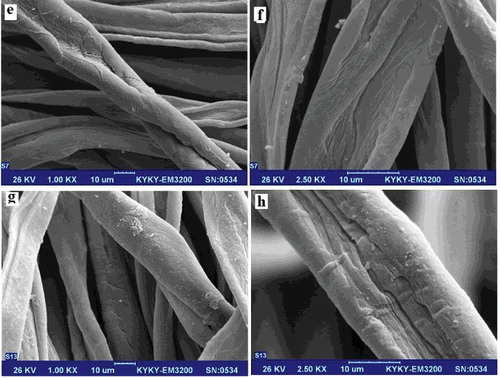
As it was mentioned in the experimental part, both untreated and plasma-treated samples were inoculated with carboxylated CNT, and the absorption of CNT on different samples were studied using different analysis. Scanning electron micrographs of cotton fabrics applying with CNTs have been shown in . SEM examination revealed the presence of CNTs on the cotton fiber surface.
There are some amounts of CNTs observed on the surface of the untreated cotton fibers and the presence of CNTs on the fiber surface of plasma-treated cotton fabrics is more. Also, more amounts of CNTs are observed on the surface of cotton fabric in the case of using nitrogen plasma when compared with air plasma.
shows the photographs of CNT stabilised and plasma-treated/CNT stabilised cotton fabrics after washing. After washing, as can be seen in the , some of CNT particles are removed from untreated cotton surface, but in case of plasma-treated samples, coverage of CNTs on cotton fiber surface can be seen, even after washing, more amounts of CNTs remained on the surface of washed cotton fabric in the case of using nitrogen plasma.
Samples that were pre-activated with plasma had a better washing durability than untreated samples.
As it was mentioned before, after plasma treatment, the water absorption time is decreased. The decrease of water-absorption time can be attributed to the introduction of polar groups due to plasma chemical modification and morphological changes. The formation of additional functional groups and morphological changes at the surface is probably the most significant contribution of the plasma treatment to the adhesion improvements.
As it can be seen in , the reflection factor for plasma-treated samples is less than untreated one and the effect of plasma treatment followed by CNT stabilisation on fabric is more pronounced. As a result, plasma/CNT-treated fabrics showed lower R%. It is related to more amount of CNT absorbed by plasma-treated sample. The results confirm the data achieved by SEM.
After CNT inoculation, the water absorption time was measured. The results are shown in . As can be seen, after CNT loading, the samples will be more hydrophobic when compared with the results presented in .
Table 2. Electrical resistance and water absorption time result of untreated and plasma-treated cotton fabrics after CNT inoculation.
After CNT inoculation, the presence of CNTs on the fiber surface of both treated and untreated cotton fabrics is obvious, and the surface of sample covered by CNTs and the polar groups grafted with CNT particles. So, the free groups which can absorb water decreased and the samples will be more hydrophobic.
Also, the electrical conductivity of CNT-inoculated samples, before and after washing, was measured by two-probe resistivity measurement in normal environment at 65% RH and results are shown in . As it was expected, by plasma treatment of samples, the electrical resistance decreases, so the electrical conductivity increases. Also, according to the results, effect of the nitrogen plasma/CNT on the increasing of cotton fabric electrical conductivity is more than air plasma/CNT treatment. Plasma treatment caused a great decrease in the surface resistance. However, there was no considerable change in the conductivity of samples after washing. The electrical resistivity of untreated/CNT-inoculated cotton increases after washing and it shows that, more amounts of CNT have been removed after washing.
FT-Raman spectroscopy studies were carried out on untreated, CNT-inoculated and plasma-treated/CNT-inoculated cotton fabric ().
From the Raman results of untreated cotton, a band located at 1151 cm−1 is characteristic of cellulose. For the cotton fiber, the strong band at 2908 cm−1 is due to the symmetric and asymmetric stretching vibrations of CH2. The band at 1389 cm−1 is associated with the CH2 deformation vibration. The band appearing at 381 cm−1 is ascribed to skeletal C–O–C, C–C–C, O–C–C and O–C–O ring deformation vibrations. No intensity can be seen for O–H stretching vibrations of the cellulose chains in the Raman spectrum. Researchers confirmed that the O–H bonds are weakly polarisable in Raman spectroscopy, and these groups are usually invisible.[Citation19–26]
The results of CNT-treated samples show that these are undoubtedly pristine single-walled CNTs with the SWNT-unique radial breathing mode (at 100–300 cm−1), the disorder mode (D-band at around 1300 cm −1) and the characteristic tangential mode (G-band at 1590 cm−1). For CNTs, the intensity of D-band was found to be less than that of G-band, indicating that tubes were of very good quality. In addition, G-band is assigned to the tangential radial mode of graphite, and D-band is contributed due to the Raman mode of the amorphous carbon. A second-order mode of 2686 cm−1 observed is assigned to the first overtone of the D mode and is often called G´mode.[Citation27,Citation28]
For plasma/CNT-treated samples, the intensity of D-band was found to be less than that of G-band (the intensity ratio (D/G ratio) was less than 1/20), indicating that the SWNT sidewalls were pristine and are successfully stabilised on the plasma-treated cotton fabric. In case of plasma/CNT-inoculated samples, it is evidenced that the intensity of both G-band and D-band is more when compared with untreated/CNT inoculated one. It confirms the results achieved by SEM and can conclude that more amounts of CNT can be absorbed by plasma-treated samples. As it was mentioned, on the surface of nitrogen plasma-treated sample, the existence of positive groups is more than air plasma-treated one and by nitrogen plasma treatment, it is possible to successfully convert cotton into a cationic material. So, the surface of nitrogen plasma-treated sample has more affinity to absorb carboxylated single-wall nanotubes which has negative charge.
The antibacterial activity results of samples are shown in . Because of chemical modification and physical etching after plasma treatment, more amounts of CNT are absorbed on the surface of cotton fabric. The results of the counting test showed more reduction in the survival of bacteria in the case of plasma modification/CNT stabilisation. This is because the interaction between CNT and bacteria can change the metabolic activity of bacteria and eventually cause their death.
Also, the existence of nitrogen-containing groups on the surface of N2 plasma-treated cotton causes an increase in the reduction percentage of bacteria.
4. Conclusion
CNTs were stabilised on the surface of plasma-pretreated cotton fabric. Results indicate that the nitrogen plasma treatment successfully converted cotton into a cationic material and after plasma treatment, the time of water absorption is decreased noticeably and cotton fabrics will be more hydrophilic. From the results of SEM, it can be concluded that, more amounts of CNTs are observed on the surface of cotton fabric in the case of using nitrogen plasma pretreatment. After washing, CNT particles are removed from untreated cotton surface, but in case of plasma-treated samples, the coverage of CNTs on cotton fiber surface can be seen, even after washing the samples. As a result of reflective spectrophotometer, plasma/CNT-treated fabrics showed lower R% and it is related to more amount of CNT absorbed by plasma-treated sample. From the results of Raman spectroscopy, it can be concluded that for plasma/CNT-treated samples, the intensity of D-band was found to be less than that of G-band, indicating that the SWNT sidewalls were pristine and are successfully stabilised on the plasma-treated cotton fabric. Plasma treatment caused a great decrease in the surface resistance and there was no considerable change in the conductivity of samples after washing. The results of the antibacterial counting test showed more reduction of survival of bacteria in the case of plasma modification/CNT stabilisation.
Disclosure statement
No potential conflict of interest was reported by the authors.
References
- Devaux E, Koncar V, Kim B, et al. Processing and characterization of conductive yarns by coating or bulk treatment for smart textile applications. Trans Institute Meas Control. 2007;29(3/4):355–376.
- Favini E, Agnihotra S, Surwade SP, et al. Sensing performance of electrically conductive fabrics and suspension lines for parachute systems. J Intell Mat Syst Struct. 2012;23:1969–1986.
- Laxminarayana K, Jalili N. Functional nanotube-based textiles: pathway to next generation fabrics with enhanced sensing capabilities. Text Res J. 2005;75:670–680.
- Kumar Mishra A, Arockiadoss T, Ramaprabhu S. Study of removal of azo dye by functionalized multi walled carbon nanotubes. Chem Eng J. 2010;162:1026–1034.
- Varesano A, Tonin C. Improving electrical performances of wool textiles: synthesis of conducting polypyrrole on the fiber surface. Textile Res J. 2008;78:1110–1115.
- Bradford PD, Bogdanovich AE. Electrical conductivity study of carbon nanotube yarns, 3-D hybrid braids and their composites. J Compos Mater. 2008;42:1533–1545.
- Bouchard J, Cayla A, Lutz V, et al. Electrical and mechanical properties of phenoxy/multiwalled carbon nanotubes multifilament yarn processed by melt spinning. Text Res J. 2012;82:2106–2115.
- Sonoyama N, Ohshita M, Nijubu A, et al. Synthesis of carbon nanotubes on carbon fibers by means of two-step thermochemical vapor deposition. Carbon. 2006;44:1754–1761.
- Thakre PR, Lagoudas DC, Riddick JC, et al. Investigation of the effect of single wall carbon nanotubes on interlaminar fracture toughness of woven carbon fiber–epoxy composites. J Compos Mater. 2011;45(10):1091–1107.
- An F, Lu C, Guo J, et al. Preparation of vertically aligned carbon nanotube arrays grown onto carbon fiber fabric and evaluating its wettability on effect of composite. Appl Surf Sci. 2011;258:1069–1076.
- Alimohammadi F, Parvinzadeh Gashti M, Shamei A. Functional cellulose fibers via polycarboxylic acid/carbon nanotube composite coating. J Coat Technol Res. 2013;10(1):123–132.
- Mei L, He X, Li Y, et al. Grafting carbon nanotubes onto carbon fiber by use of dendrimers. Mat Lett. 2010;64:2505–2508.
- Shahidi S, Rashidi A, Ghoranneviss M, et al. Investigation of metal absorption and antibacterial activity on cotton fabric modified by low temperature plasma. Cellulose. 2010;17:627–634.
- Zhang X, Yang B, Wang X, et al. Effect of plasma treatment on multi-walled carbon nanotubes for the detection of H2S and SO2. Sensors. 2012;12(7):9375–9385.
- Shahidi S, Ghoranneviss M. Sterilization of cotton fabrics using plasma treatment. Plasma Sci Technol. 2013;15(10):1031–1033.
- Shahidi S, Aslan N, Ghoranneviss M, et al. Effect of thymol on the antibacterial efficiency of plasma treated cotton fabric. Cellulose. 2014;21(3):1933–1943.
- Shahidi S, Ghoranneviss M, Moazzenchi B. New advances in plasma technology for textile. J Fusion Energy. 2014;33:97–102.
- Kan CW, Lam YL, Yuen CWM. Microscopic study of cotton fibre subjected to different functional treatments. In: Méndez-Vilas A, editor. Current microscopy contributions to advances in science and technology. Badajoz (Spain): Taylor & Francis; 2012. p. 1130–1136.
- Oh J, Chang YW, Kim HJ, et al. Carbon nanotube-based dual-mode biosensor for electrical and surface plasmon resonance measurements. Nano Lett. 2010;10:2755–2760.
- Atalla RH. Celluloses. In: Pinto BM, editor. Comprehensive natural products chemistry: carbohydrates and their derivatives including tannins, cellulose and related lignins. Vol. 3. Amsterdam: Taylor & Francis; 1999. p. 529–598.
- Atalla RH, Isogai A. Raman and infrared spectra. In: Mander L, editor. Comprehensive natural products II: chemistry and biology. Oxford: Taylor & Francis; 2010. p. 509–511.
- Eichhorn SJ, Sirichaisit J, Young RJ. Deformation mechanisms in cellulose fibers, paper and wood. J Mater Sci. 2001;36:3129–3135.
- Eichhorn SJ, Baillie CA, Zafeiropoulos N, et al. Review: current international research into cellulosic fibers and composites. J Mater Sci. 2001;36(9):2107–2131.
- Gierlinger N, Schwanninger M, Reinecke A, et al. Molecular changes during tensile deformation of single wood fibers followed by Raman microscopy. Biomacromolecules. 2006;7:2077–2081.
- Hieu HC, Tuan NA, Li H, et al. Sum frequency generation microscopy study of cellulose fibers. Appl Spectrosc. 2011;65(11):1254–1259.
- Agarwal UP, Reiner RS, Ralph SA. Cellulose I crystallinity determination using FT–Raman spectroscopy: univariate and multivariate methods. Cellulose. 2010;17:721–733.
- Rakhi RB, Sethupathi K, Ramaprabhu S. Field emission from carbon nanotubes on a graphitized carbon fabric. Carbon. 2008;46:1656–1663.
- Booker RD, Green MJ, Fan H, et al. High-shear treatment of single-walled carbon nanotube–superacid solutions as a pre-processing technique for the assembly of fibres and films. Proc Inst Mech Eng Part N J Nanoeng Nanosyst. 2008;222:101–109.

